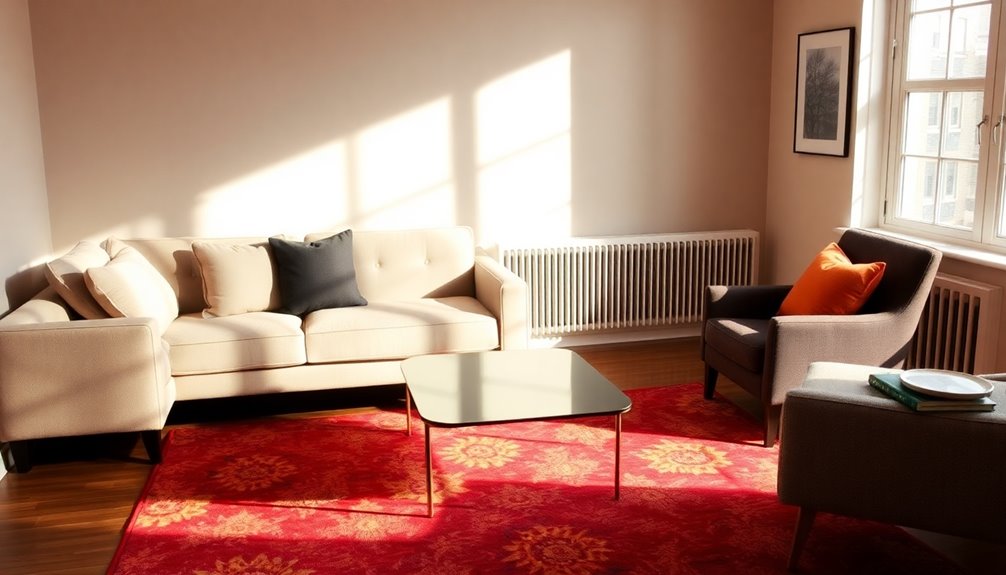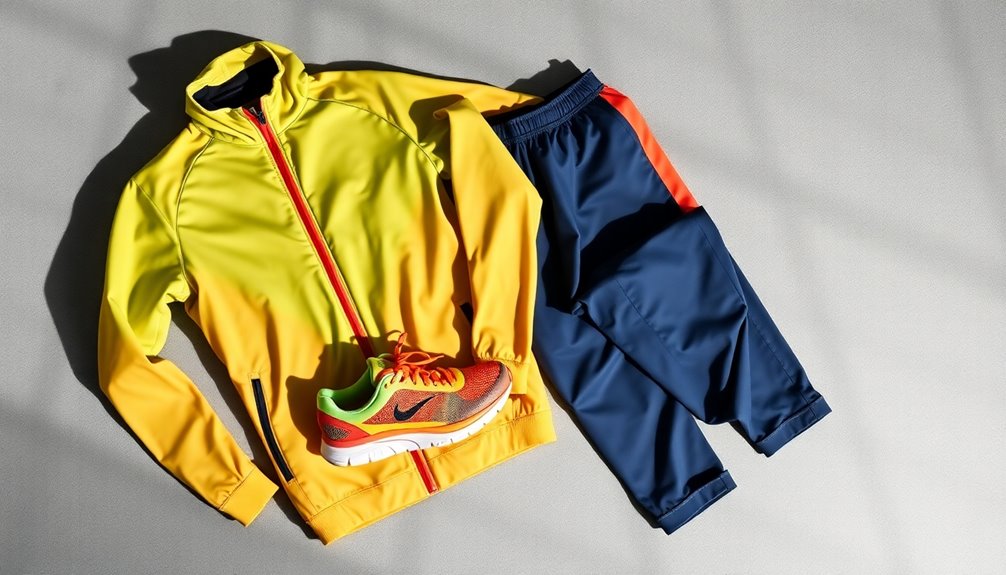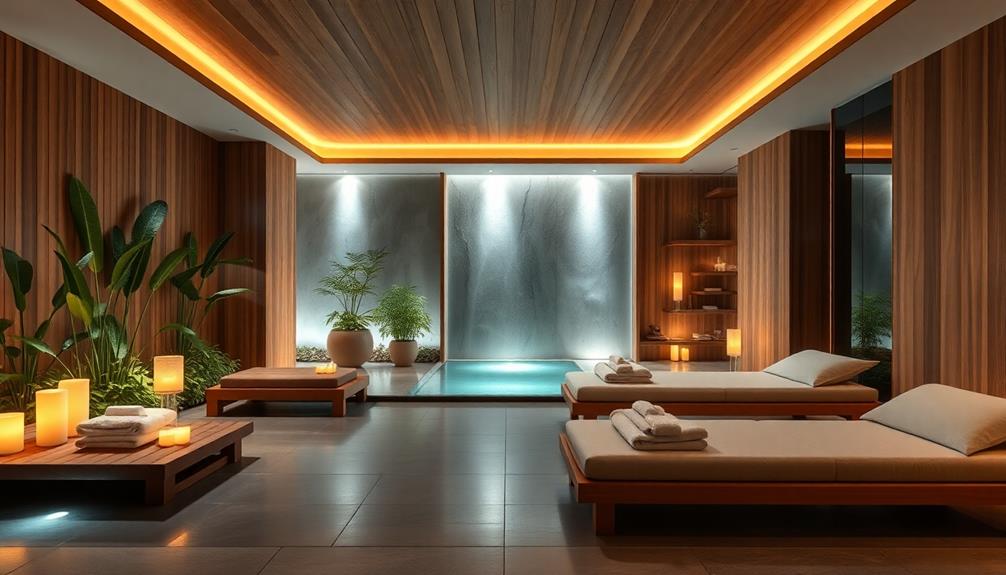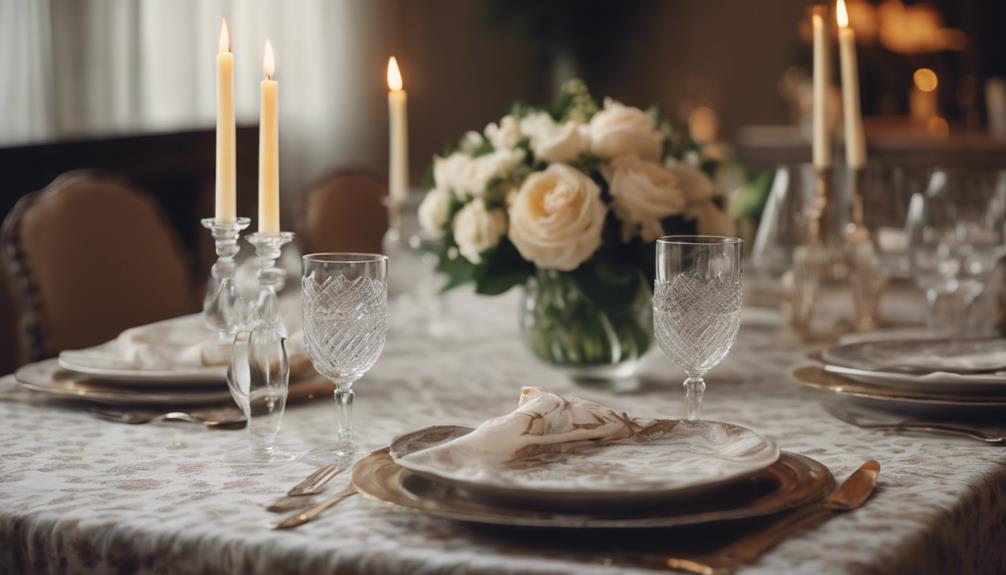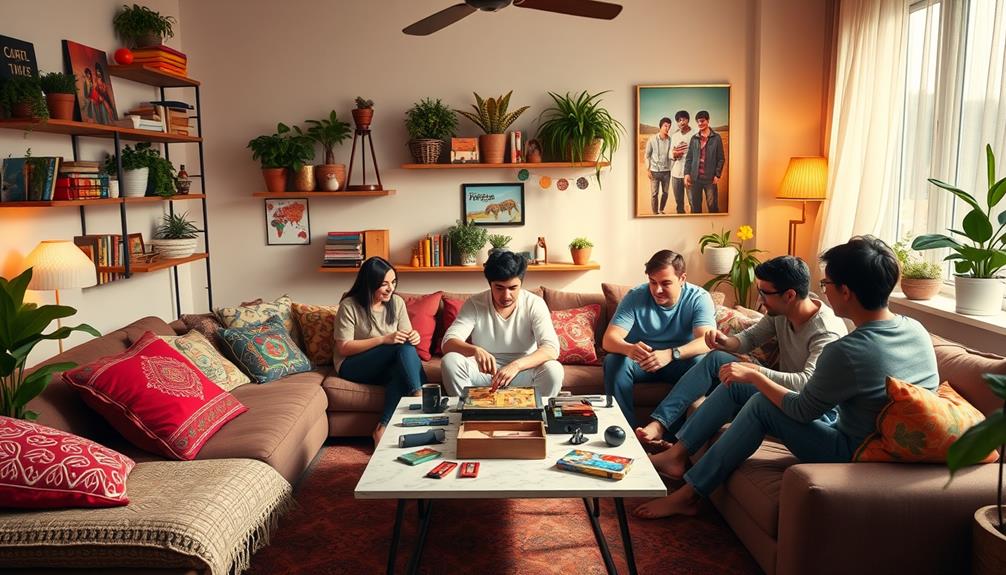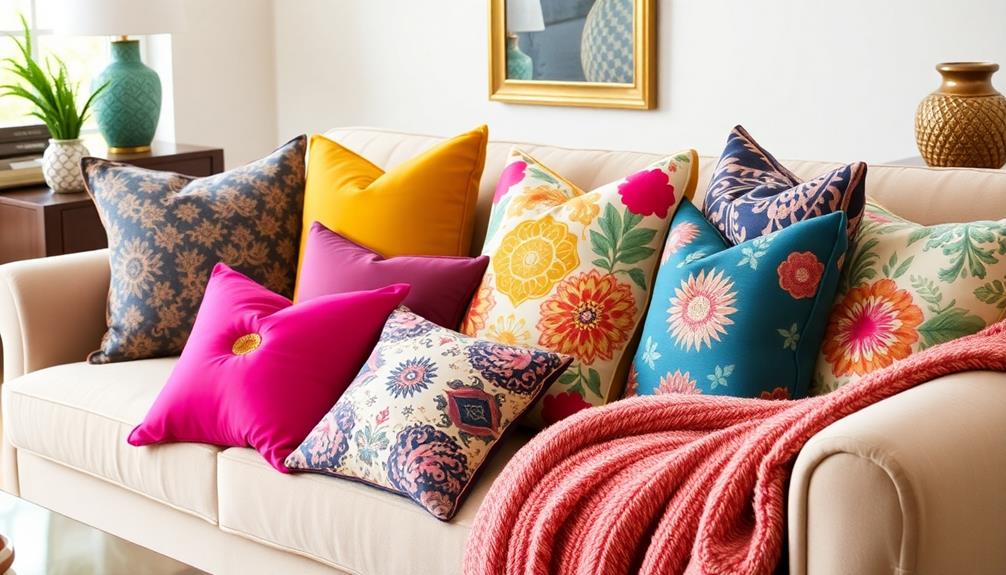To arrange furniture around baseboard heaters, start by ensuring you maintain at least 12 inches of clearance in front and 6 inches on each side for proper airflow. Position slim or low-profile furniture 6 to 12 inches away to prevent fire hazards and allow heat distribution. Create a cozy setting by coming up with a seating area that invites warmth while allowing for air circulation. Avoid bulky items directly in front of heaters, and consider using decorative elements or plants to enhance the space's aesthetic. If you're looking for more tips on arrangement and safety, keep exploring!
Key Takeaways
- Maintain 6 to 12 inches of space between furniture and heaters to ensure proper airflow and prevent fire hazards.
- Avoid placing large or bulky furniture directly in front of heaters to facilitate heat distribution and air circulation.
- Use furniture with legs to promote airflow under and around heaters, preventing obstructions that can lead to overheating.
- Create a cozy seating area around heaters while strategically using decor to divert attention away from the heating elements.
- Regularly clean baseboard heaters every 3-6 months to maintain efficient operation and prevent dust accumulation near furniture.
Minimum Clearance Requirements
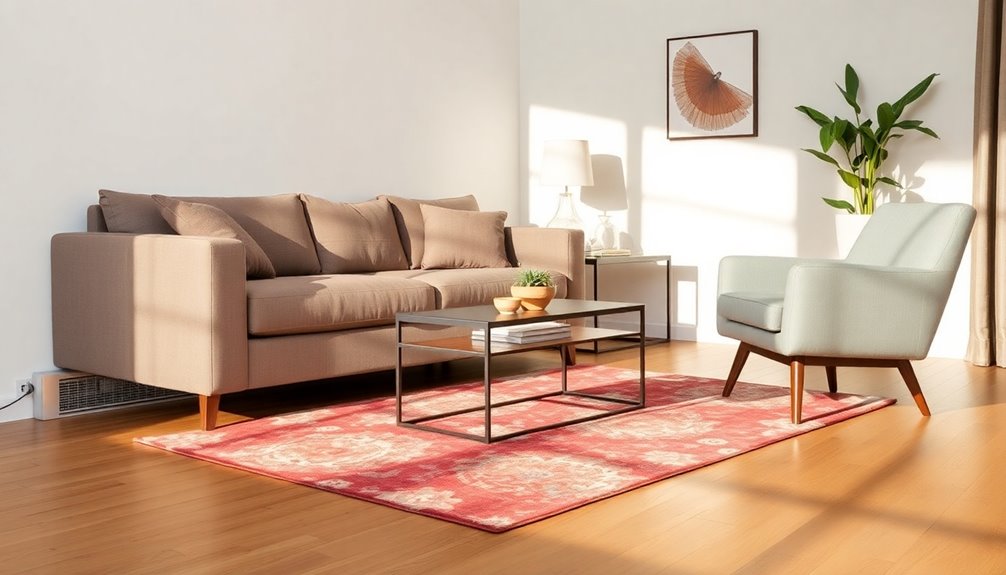
When arranging furniture around baseboard heaters, it's essential to prioritize minimum clearance requirements to ensure safety and efficiency. You should maintain at least 12 inches of clearance in front of the heater to promote proper airflow and heat distribution. If your heater has a fan, keep a minimum of 3 feet clear in front of it; blocking this area can create fire hazards and reduce performance.
On each side of the heater, at least 6 inches of clearance is necessary. Keep combustible materials, like drapes and furniture, away from this zone. While the ends of the heater can touch baseboard wall trim, other items must stay clear.
Above the heater, ensure there's a minimum of 12 inches of clearance. Avoid placing electrical outlets above the heater due to fire risks, and steer clear of any combustible materials in this space. Additionally, consider consulting trained HVAC professionals to address specific safety and efficiency needs.
Remember to install baseboard heaters horizontally and within 1/4-inch of level to optimize performance. Regularly inspect your setup to make sure all clearance requirements are met, preventing potential fire hazards and ensuring efficient heating throughout your space.
Effective Furniture Placement
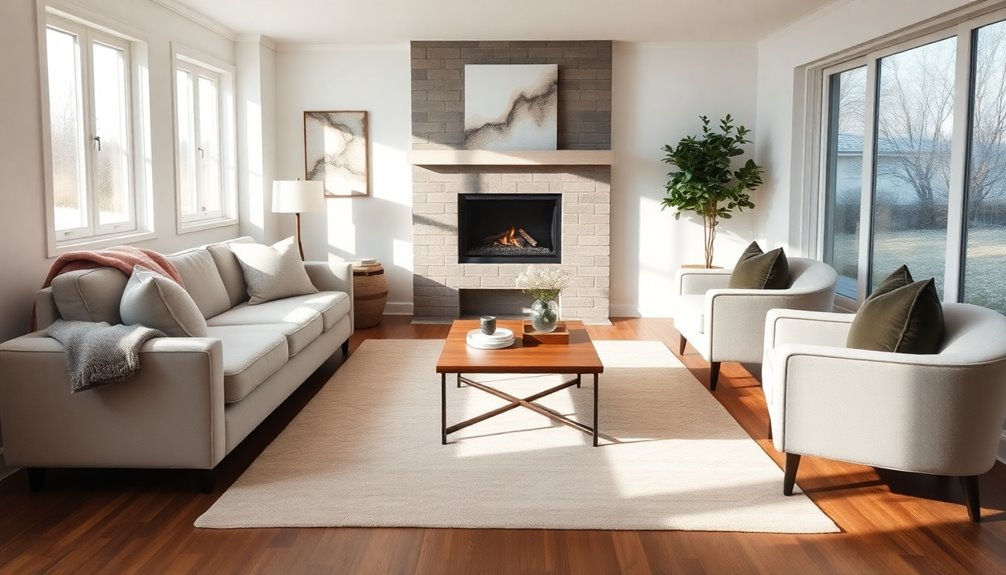
Effective furniture placement around baseboard heaters can make a significant difference in both safety and comfort. To ensure safety, keep all furniture and draperies at least 6 to 12 inches away from the heaters. This distance helps prevent fire hazards and avoids damage to your heating system. It's crucial to avoid placing flammable materials near the heaters and to regularly check for any items that might have fallen onto or beneath them. Maintaining a minimum clearance is essential for optimal heater performance and safety.
For optimal room layout, arrange your furniture to encourage a smooth flow, using a mix of shapes and sizes for visual interest. Avoid large pieces directly in front of the heaters, as this can obstruct airflow. Instead, consider utilizing slimmer furniture that allows better air circulation and heat distribution.
Embrace the heaters as part of your decor. You can create a cozy seating area around them, using decorative elements like throw pillows or area rugs to enhance the space. Remember, experimenting with different arrangements can help you achieve the right balance of functionality and aesthetics while maintaining safety and efficiency.
Ensuring Air Circulation
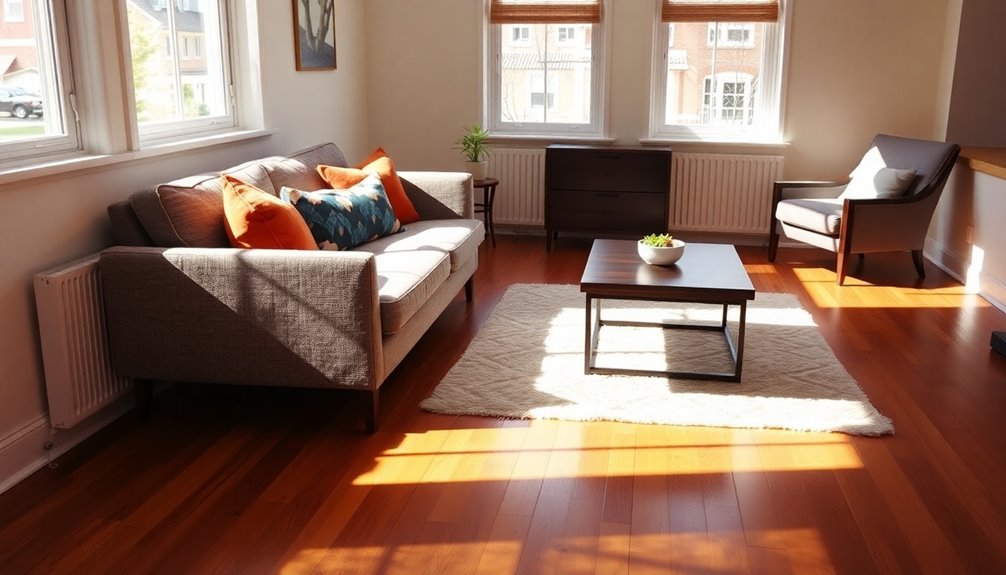
Ensuring proper air circulation around baseboard heaters is crucial for maintaining an efficient heating system. To achieve this, leave at least 12 inches (30 cm) of space between the heater and any furniture. Avoid placing large or bulky pieces directly in front, as this obstructs airflow and hampers heat distribution. Keep the area around the heaters clear; no curtains, rugs, or fabric items should be near them, as they can catch fire or block airflow.
Opt for smaller or low-profile furniture, like short dressers or benches. Choose pieces with legs that allow warm air to flow underneath, enhancing the convection process. Floating furniture creates an open feel while ensuring heat is evenly distributed. Slimline pieces can fit alongside baseboard heaters without obstructing airflow, and materials like metal, glass, or stone can withstand higher temperatures. Regularly maintaining a 1-inch gap between the floor and heating element is crucial for maximizing heater efficiency.
If your heater is located beneath a window, ensure curtains stop just above it to prevent trapping heat. Use shorter window treatments or heat-resistant curtain liners to enhance safety while ensuring that none block the natural convection process of the heater. By managing these aspects, you'll ensure optimal air circulation and comfort in your space.
Safety Precautions
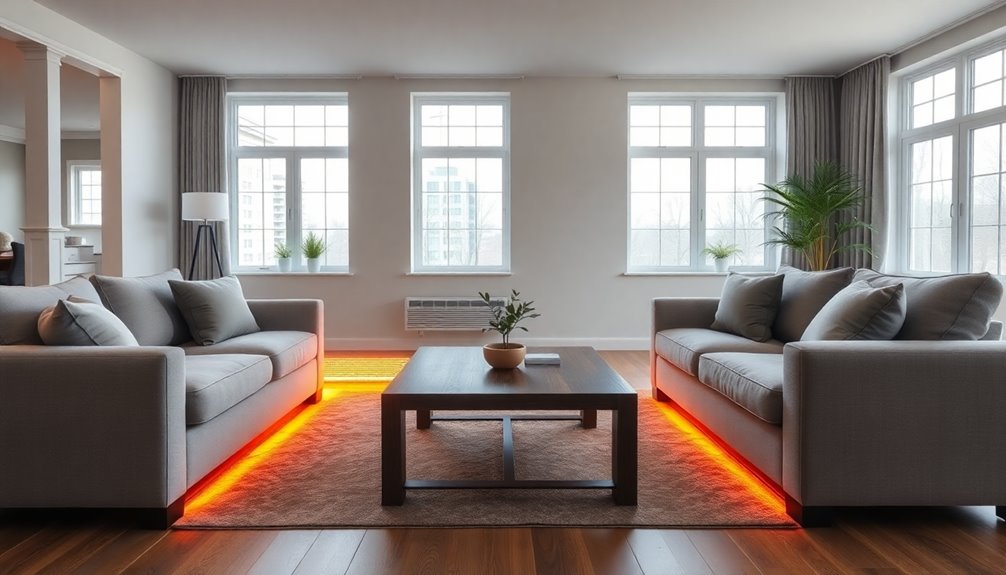
How can you keep your home safe while using baseboard heaters? Start by ensuring that all furniture is at least 6 inches away from the heater. This distance helps prevent obstructions that could lead to fire hazards. Additionally, keep curtains, draperies, and any flammable materials at least 6 to 12 inches away.
Avoid placing blankets, paper, or toys near the heater, as these could easily ignite. Make sure no electrical cords or heat-sensitive items are in close proximity, and don't block airflow or allow objects to touch the heating element. Regularly monitoring airflow management is essential to ensure the heater operates efficiently.
If you have small children, supervise them around electric baseboard heaters to prevent accidental contact with hot surfaces. Teach them about the dangers of heaters, so they understand how to stay safe. It's also wise to keep pets away from the heaters to avoid any mishaps.
Lastly, regular maintenance is crucial. Clean the baseboard heater every 3-6 months to clear dust and debris that could cause overheating. Vacuum both the inside and outside, and check for signs of wear or damage. Having a professional inspect the heater periodically will ensure it operates safely and efficiently.
Installation Guidelines
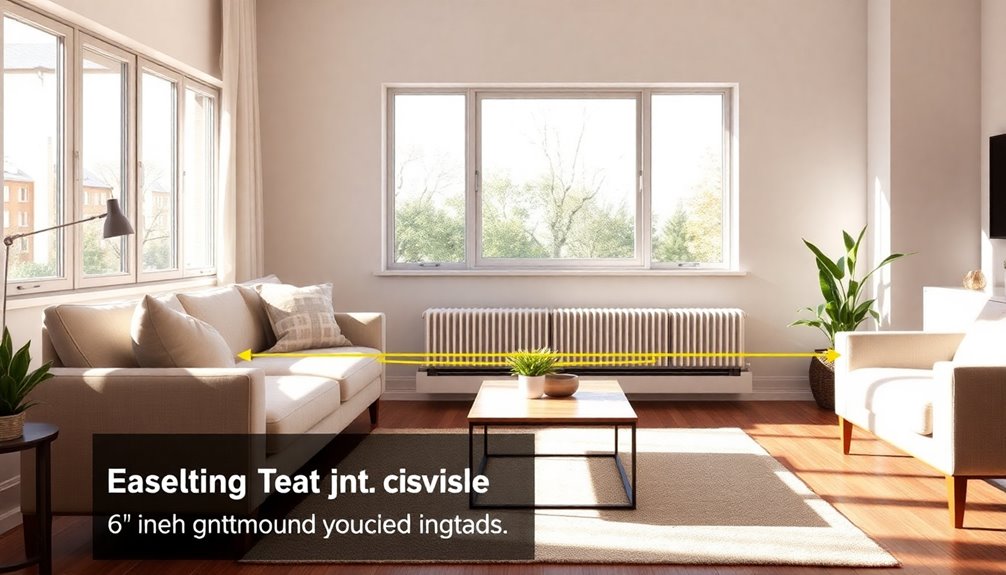
After taking the necessary safety precautions, it's time to focus on the proper installation of baseboard heaters. Start by positioning the heater at floor-level, ensuring it rests directly on the floor. There's no maximum height restriction, but the heater must be installed horizontally and within 1/4-inch of level. Use a bubble level for alignment.
Next, maintain proper clearance around the heater. Keep at least 12 inches clear in front and 6 inches on the sides. Electric outlets should be positioned at least 12 inches away, with below placement generally discouraged. Ensure doors don't block the heater; they should remain 12 inches away when fully open.
Avoid obstructions that can hinder airflow. Furniture, curtains, or rugs should never block the heater. Opt for furniture with legs to allow warm air to circulate, and ensure that there is enough clearance to allow for unobstructed airflow. If your room has thick carpeting, install the heater above it to prevent air intake issues. Consider using shorter baseboard heaters around existing outlets. Lastly, make sure curtains or blinds stop just above the heater to minimize fire hazards. Follow these guidelines carefully to ensure safe and efficient heating.
Aesthetic Considerations
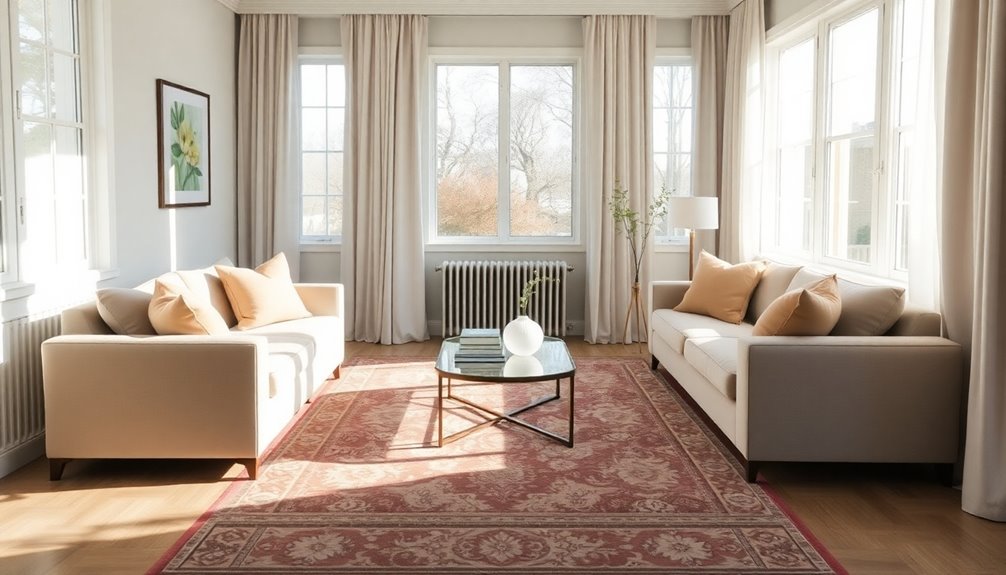
Integrate baseboard heaters into your room design by focusing on both functionality and aesthetics. Start by selecting decorative covers made of wood, metal, or plastic to hide their utilitarian look while enhancing your space's appeal. You can choose covers that match your wall color for a subtle touch or opt for contrasting shades to turn the heaters into design features. Additionally, consider that new decorative covers can significantly upgrade the overall aesthetic compared to standard options. It's important to remember that maintaining a comfortable room temperature can also improve your overall well-being.
To further distract from the heaters, arrange nearby decor strategically. Hang wall art or apply decals around them, using potted plants or decorative baskets to draw the eye elsewhere. Creating a gallery wall nearby can add charm without highlighting the heaters.
When placing furniture, prioritize airflow and heat distribution. Use slimline pieces or furniture with legs alongside the heaters for optimal circulation. Position larger, attractive items like sofas or armchairs in front of the heaters to create a focal point while maintaining a cozy seating area. Additionally, consider the flow of your space by ensuring that pathways remain clear and accessible. When thinking about how to style a sofa table, incorporate decorative elements that enhance both functionality and aesthetics. This could include a mix of books, plants, and personalized decor to create a welcoming atmosphere without obstructing airflow.
Finally, treat the heater covers as part of your room's trim and consider using LED strip lighting for an ambient glow. With these aesthetic considerations, your baseboard heaters can blend seamlessly into your design while remaining functional.
Tips for Maintenance
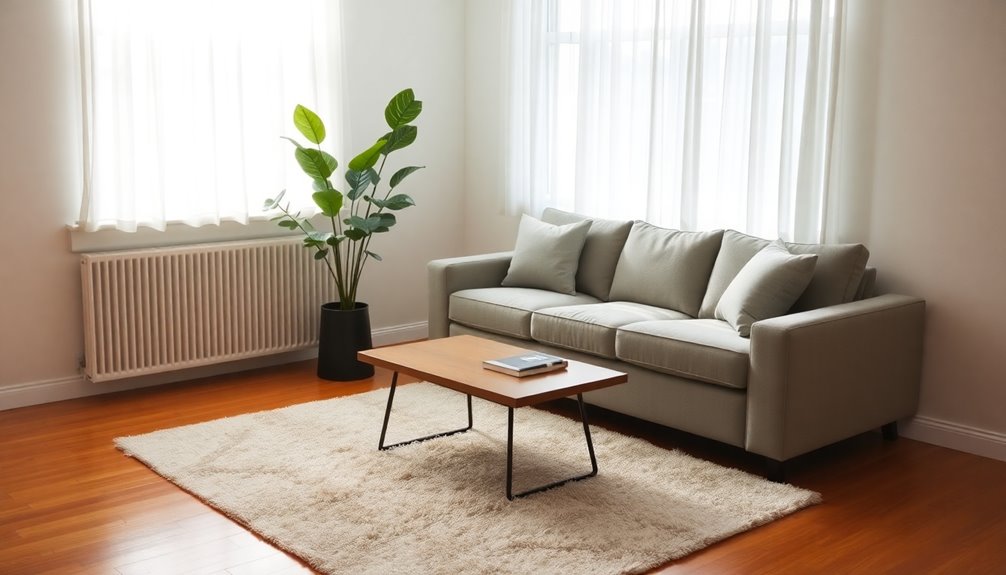
While you've taken steps to enhance the aesthetics of your space, maintaining baseboard heaters is key to ensuring they operate efficiently. Start by regularly cleaning the heaters. Always turn off the power at the circuit breaker before you begin. Remove the front cover and use a vacuum with a brush attachment or a dry microfiber cloth to eliminate dust and debris from the fins. If you notice bent fins, straighten them with a putty knife or needle-nose pliers.
Next, ensure proper clearance and airflow. Maintain a distance of at least 6-12 inches between furniture and baseboard heaters, keeping large items like wardrobes away. Opt for furniture with legs to promote air circulation and ensure curtains don't block the heaters. Regular cleaning will also enhance heating efficiency by removing dust and debris.
Don't forget preventive measures. Vacuum around the heaters regularly and wipe them down with a dryer sheet monthly to repel dust. Seal any cracks around doors and windows to minimize debris.
Lastly, prioritize safety. Ensure units are cool before cleaning, keep flammable materials clear, and supervise children around heaters. Always check circuit breakers if heaters aren't functioning after maintenance.
Frequently Asked Questions
Can I Use Rugs Near Baseboard Heaters?
You shouldn't use rugs near baseboard heaters. They can obstruct airflow and create fire hazards, especially if they're flammable. Keeping at least 6 inches of clearance is essential for safety and efficiency. If you want to add warmth to your space, consider using low-profile rugs placed away from the heater. Always prioritize safety by ensuring nothing flammable is nearby, and regularly check the area for any potential risks.
What Type of Furniture Is Safest Near Heaters?
When choosing furniture near heaters, opt for smaller, low-profile pieces that won't block airflow. Furniture with legs allows warm air to circulate underneath, ensuring comfort. Select heat-resistant materials like metal or glass, which can withstand higher temperatures. Avoid flammable items made of wood or fabric, as they pose fire risks. Keep furniture at least 6-12 inches away from the heater for safety and optimal heat distribution throughout your space.
How Can I Hide Baseboard Heaters Effectively?
To hide baseboard heaters effectively, consider installing decorative covers that blend with your wall color. You can also use curtains that stop just above the heaters, ensuring they don't obstruct airflow. Distract attention with nearby decor like wall art or potted plants. Additionally, arrange furniture strategically by keeping it at least 12 inches away from the heaters, allowing for proper airflow while maintaining a cohesive look in your space.
Are There Baseboard Heater Covers Available?
Yes, there are plenty of baseboard heater covers available. You can choose from materials like aluminum, steel, or plastic, each offering different benefits. Aluminum is durable and lightweight, while steel provides a modern look and customization options. Many covers are easy to install and come in various colors. Just make sure you measure accurately for a perfect fit, and consider compatibility with your heating system for the best results.
How Do I Clean Around Baseboard Heaters Safely?
To clean around baseboard heaters safely, start by turning off the power at the circuit breaker. Once the units are cool, remove the front covers carefully. Use a dry microfiber cloth or a vacuum with a soft brush attachment to eliminate debris inside. Avoid using water or abrasive cleaners. When you're done, reattach the covers securely, restore power, and ensure everything's clean and functioning properly. Keep the area clear to prevent accidents.
Conclusion
By keeping these guidelines in mind, you can successfully arrange your furniture around baseboard heaters without sacrificing comfort or safety. Always maintain the minimum clearance for effective heat circulation and choose placements that enhance your room's aesthetic. Don't forget to check your heaters regularly for maintenance. With thoughtful positioning, you'll create a cozy, inviting space that maximizes warmth while looking great. Enjoy your beautifully arranged room and the cozy warmth it provides!
